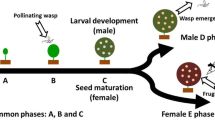Abstract
The relationship between fig trees and their pollinator wasps is a well-known example of species-specific obligate mutualism. In this article we present a stochastic model of this mutualistic system, referring to data on a dioecious fig (Ficus schwarzii) in Borneo, and examine the conditions for the persistence of a wasp population for a given period. (1) When the average duration of the flowering interval of fig trees is short, even a small fig population can sustain a wasp population successfully. A population whose average period of flowering cycle is half that of another population can sustain a wasp population with a number of trees less than half of the other population. (2) The wasp survival rate (WSR) is higher when (a) the variation of the interval periods of fig flowering is smaller, (b) the fig population size is larger, and (c) figs can prolong their receptivity to wait for a wasp if no wasps are available. (3) WSR is predictable from the average proportion of the fig's receptive phases, in which wasps are available, to their total receptive phases. (4) The persistence period of a wasp population increases exponentially with the number of fig trees. Based on these results we propose a new hypothesis, as a possible scenario, on the evolution of dioecy from monoecy in Ficus.
Similar content being viewed by others
Author information
Authors and Affiliations
Additional information
Received: November 13, 1998 / Accepted: July 14, 1999
Rights and permissions
About this article
Cite this article
Kameyama, T., Harrison, R. & Yamamura, N. Persistence of a fig wasp population and evolution of dioecy in figs: a simulation study. Res Popul Ecol 41, 243–252 (1999). https://doi.org/10.1007/s101440050028
Issue Date:
DOI: https://doi.org/10.1007/s101440050028




